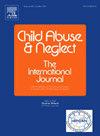Childhood maltreatment, sexual desire and sexual distress in couples: the role of touch aversion
IF 3.4
2区 心理学
Q1 FAMILY STUDIES
引用次数: 0
Abstract
Background
Childhood maltreatment (CM), experienced by about 40 % of adults, is associated with romantic relationship challenges like instability, sexual dissatisfaction, and dysfunction. While CM has been linked to lower sexual desire and higher distress, its impact within couples and underlying mechanisms remain underexplored. Touch aversion, where partner touch feels unpleasant, may explain how CM relates to lower sexual desire and higher sexual distress.
Objective
This study explores the mediating role of touch aversion in the associations between CM, sexual desire and sexual distress in couples.
Methods
A sample of 363 adult couples completed self-reported online questionnaires on CM, partner-focused sexual desire, sexual distress and touch aversion.
Results
A person's CM is indirectly associated with their own lower sexual desire (b = − 0.07, 95 % bootstrap CI = [−0.08, −0.02]), their partner's higher sexual desire (b = 0.01, 95 % bootstrap CI = [0.000, 0.02]), and both their own (b = 0.06, 95 % bootstrap CI = [0.01, 0.03]) and their partner's higher sexual distress (b = 0.02, 95 % bootstrap CI = [0.003, 0.013]) through their own higher touch aversion.
Conclusions
These findings provide theoretical support for the role of touch aversion in the sexual dynamics of couples reporting CM, underscoring the interdependent nature of partners' sexual desire and distress. Clinically, understanding how individuals with a CM history respond to touch may highlight a modifiable psychological process that could help couples navigate their sexual desire and distress.
童年虐待、性欲和夫妻间的性困扰:触摸厌恶的作用
大约40%的成年人经历过童年虐待,这与不稳定、性不满和功能障碍等浪漫关系挑战有关。虽然CM与较低的性欲和较高的痛苦有关,但其对夫妻的影响及其潜在机制仍未得到充分研究。厌恶触摸,即伴侣的触摸会让人感到不愉快,这或许可以解释CM与性欲低下和性痛苦加剧之间的关系。目的探讨触摸厌恶在夫妻性行为、性欲和性痛苦之间的中介作用。方法对363对成年夫妇进行CM、伴侣关注性欲望、性困扰和触碰厌恶等在线自填问卷。结果a人的CM与自身较低的性欲(b = - 0.07, 95% bootstrap CI =[- 0.08, - 0.02])、伴侣较高的性欲(b = 0.01, 95% bootstrap CI =[0.000, 0.02])以及自身较高的触碰厌恶程度(b = 0.06, 95% bootstrap CI =[0.01, 0.03])和伴侣较高的性痛苦(b = 0.02, 95% bootstrap CI =[0.003, 0.013])间接相关。结论这些发现为接触厌恶在报告CM的夫妻的性动力中的作用提供了理论支持,强调了伴侣的性欲和痛苦的相互依赖性质。从临床角度来看,了解有CM病史的个体对触摸的反应可能会强调一种可改变的心理过程,这种心理过程可以帮助夫妻应对他们的性欲和痛苦。
本文章由计算机程序翻译,如有差异,请以英文原文为准。
求助全文
约1分钟内获得全文
求助全文
来源期刊

Child Abuse & Neglect
Multiple-
CiteScore
7.40
自引率
10.40%
发文量
397
期刊介绍:
Official Publication of the International Society for Prevention of Child Abuse and Neglect. Child Abuse & Neglect The International Journal, provides an international, multidisciplinary forum on all aspects of child abuse and neglect, with special emphasis on prevention and treatment; the scope extends further to all those aspects of life which either favor or hinder child development. While contributions will primarily be from the fields of psychology, psychiatry, social work, medicine, nursing, law enforcement, legislature, education, and anthropology, the Journal encourages the concerned lay individual and child-oriented advocate organizations to contribute.
 求助内容:
求助内容: 应助结果提醒方式:
应助结果提醒方式:


